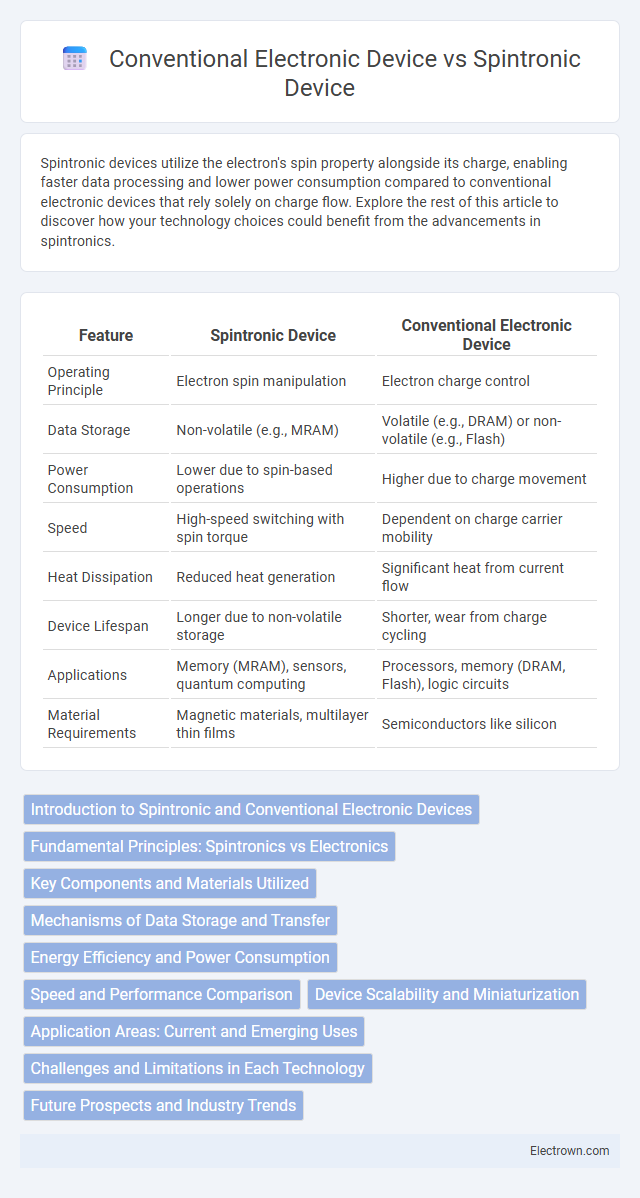Spintronic devices utilize the electron's spin property alongside its charge, enabling faster data processing and lower power consumption compared to conventional electronic devices that rely solely on charge flow. Explore the rest of this article to discover how your technology choices could benefit from the advancements in spintronics.
Table of Comparison
| Feature | Spintronic Device | Conventional Electronic Device |
|---|---|---|
| Operating Principle | Electron spin manipulation | Electron charge control |
| Data Storage | Non-volatile (e.g., MRAM) | Volatile (e.g., DRAM) or non-volatile (e.g., Flash) |
| Power Consumption | Lower due to spin-based operations | Higher due to charge movement |
| Speed | High-speed switching with spin torque | Dependent on charge carrier mobility |
| Heat Dissipation | Reduced heat generation | Significant heat from current flow |
| Device Lifespan | Longer due to non-volatile storage | Shorter, wear from charge cycling |
| Applications | Memory (MRAM), sensors, quantum computing | Processors, memory (DRAM, Flash), logic circuits |
| Material Requirements | Magnetic materials, multilayer thin films | Semiconductors like silicon |
Introduction to Spintronic and Conventional Electronic Devices
Spintronic devices utilize electron spin alongside charge to store and process information, offering enhanced speed and energy efficiency compared to conventional electronic devices that rely solely on charge. Your ability to harness spintronics enables advancements in non-volatile memory and quantum computing technologies. Conventional electronic devices, primarily based on semiconductor materials, have driven the digital revolution but face limitations in scaling and power consumption that spintronics aims to overcome.
Fundamental Principles: Spintronics vs Electronics
Spintronic devices utilize the intrinsic spin of electrons and their associated magnetic moment, enabling data storage and manipulation through spin polarization and spin currents. Conventional electronic devices rely on the electron's charge to perform operations by controlling charge flow within semiconductors. Spintronics offers advantages like non-volatility, reduced power consumption, and faster processing by exploiting quantum spin states beyond charge-based mechanisms.
Key Components and Materials Utilized
Spintronic devices utilize magnetic materials such as ferromagnets and spintronic semiconductors to manipulate electron spin, employing key components like magnetic tunnel junctions and spin valves. Conventional electronic devices primarily rely on semiconductor materials like silicon and use components such as transistors and diodes to control electron charge. The unique use of spin currents in spintronic devices allows for enhanced data storage and processing efficiencies compared to charge-based conventional electronics.
Mechanisms of Data Storage and Transfer
Spintronic devices utilize the electron's spin state, along with its charge, to store and transfer data, enabling non-volatile memory with faster switching speeds and lower power consumption compared to conventional electronic devices that rely solely on electron charge movement. The mechanism in spintronics involves manipulating spin polarization and spin currents, often through magnetic tunnel junctions or spin valves, which enhances data stability and miniaturization. Conventional electronics depend on charge accumulation and voltage differences across semiconductor materials, limiting scalability and increasing energy dissipation during data processing.
Energy Efficiency and Power Consumption
Spintronic devices leverage electron spin, enabling significantly lower power consumption compared to conventional electronic devices that rely solely on charge manipulation. The non-volatile nature of spintronic memory reduces energy usage during data retention, drastically improving overall energy efficiency in computing systems. Advances in spin-transfer torque and magnetic tunnel junctions contribute to minimizing power loss while maintaining high-speed operation.
Speed and Performance Comparison
Spintronic devices leverage the electron's spin along with its charge, enabling faster data processing speeds and reduced energy consumption compared to conventional electronic devices, which rely solely on charge. This intrinsic advantage results in higher performance with improved data retention and non-volatility, making spintronic devices ideal for advanced computing applications. Your technologies can benefit from this enhanced speed and efficiency, especially in areas demanding rapid data handling and low power usage.
Device Scalability and Miniaturization
Spintronic devices leverage electron spin rather than charge, enabling higher device scalability and miniaturization compared to conventional electronic devices limited by charge-based electron transport and heat dissipation. Their non-volatile nature and lower power consumption allow for denser integration in nanoscale circuits, enhancing performance without the severe thermal management challenges typical in traditional electronics. Your future technologies can benefit from spintronics' potential to maintain functionality at atomic scales where conventional devices face physical and quantum limitations.
Application Areas: Current and Emerging Uses
Spintronic devices excel in applications like non-volatile memory (MRAM), sensors, and quantum computing due to their low power consumption and high speed, contrasting with conventional electronic devices primarily used in logic circuits and general computing. Emerging uses of spintronics include advanced data storage solutions, spin-based transistors, and neuromorphic computing, which promise improved efficiency and faster processing. Your choice of spintronic technology can significantly enhance performance in areas requiring high-speed data transfer and reduced energy usage.
Challenges and Limitations in Each Technology
Spintronic devices face challenges such as limited spin coherence length and difficulties in efficiently generating and detecting spin currents, which restrict their scalability and integration into existing semiconductor technology. Conventional electronic devices encounter limitations including increasing power dissipation and heat generation as transistor sizes shrink, impacting performance and reliability. Understanding these constraints helps you evaluate the practical applications and future potential of each technology in advanced computing systems.
Future Prospects and Industry Trends
Spintronic devices utilize electron spin for data storage and processing, offering faster speeds and lower power consumption compared to conventional electronic devices that rely on electron charge. Industry trends indicate increasing investments in spintronics research to develop non-volatile memory, advanced sensors, and quantum computing components, highlighting a shift towards more energy-efficient and high-performance technologies. Your advantage in adopting spintronic innovations lies in staying ahead in markets demanding miniaturization and enhanced device functionality.
Spintronic Device vs Conventional Electronic Device Infographic

 electrown.com
electrown.com